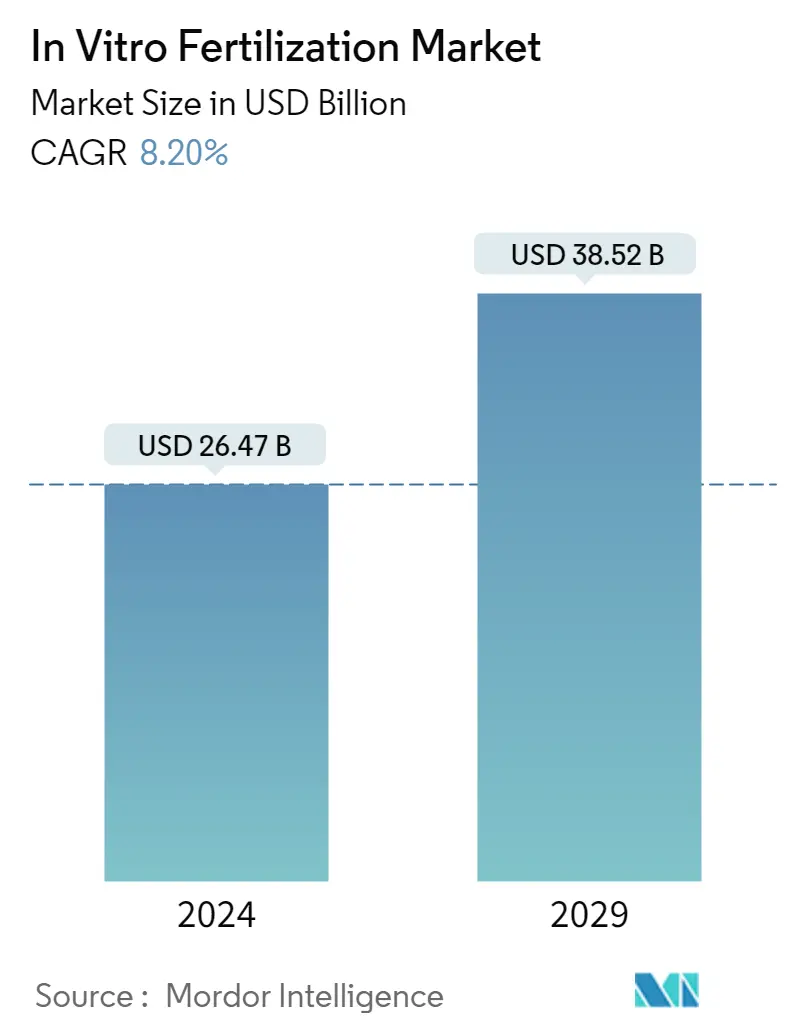Market Size of In Vitro Fertilization Industry

| Study Period | 2019 - 2029 |
| Market Size (2024) | USD 26.47 Billion |
| Market Size (2029) | USD 38.52 Billion |
| CAGR (2024 - 2029) | 8.20 % |
| Fastest Growing Market | Asia Pacific |
| Largest Market | North America |
| Market Concentration | High |
Major Players
*Disclaimer: Major Players sorted in no particular order |
In Vitro Fertilization Market Analysis
The In Vitro Fertilization Market size is estimated at USD 26.47 billion in 2024, and is expected to reach USD 38.52 billion by 2029, growing at a CAGR of 8.20% during the forecast period (2024-2029).
The COVID-19 pandemic has impacted the growth of the studied market owing to the suspension of in vitro fertilization treatments, and this had a profound impact on women undergoing IVF procedures. For instance, according to an published in Reproductive Biomedicine and Society Online, the pandemic has resulted in the large-scale cessation of assisted reproductive technology treatment in Europe owing to the closure of clinics, which resulted in delayed fertility treatment of thousands of patients in the region, especially the United Kingdom. Thus, the disrupted treatment has impacted the growth of the market during the pandemic period. However, with released restrictions and proper sanitization and measurements taken during the treatment procedures, the demand for in-vitro fertilization has increased. Thus, the studied market has witnessed significant growth and is expected to grow over the forecast period.
Factors such as the rising success rate of IVF technology, increasing awareness about IVF procedures, and delayed onset of pregnancy are expected to boost market growth over the forecast period.
Infertility continues to represent an increasing global challenge due to multiple factors such as environment, genetics, age, and comorbidities associated with impaired reproductive function. The rising number of infertile cases has increased the demand for fertility procedures that help couples with difficulties or an inability to conceive children. For instance, according to an article published in Cell in May 2022, it has been observed that male infertility is an increasing and serious medical concern that affects approximately half of infertile couples worldwide. Also, an article published in the International Bar Association in March 2022 showed that fertility rates have consistently declined to below replacement levels across developed countries globally. This is anticipated to fuel the demand for in-vitro fertilization to treat infertility issues, propelling the market growth.
Additionally, there is a growing effort by the government and other organizations to launch several campaigns to educate the public about fertility care, treatment options, and the factors contributing to infertility issues. For instance, in August 2022, Pinnacle Fertility launched the Save IVF campaign to educate on potential new legislation that threatens family-building treatment. Also, in July 2022, Oasis Fertility launched the Infertility Knows No Gender campaign to commemorate World IVF Day. IVF offers a ray of hope to millions of couples struggling with infertility.
Furthermore, the increasing launches of IVF facilities and new technologies across the globe for providing better ART services are also contributing to segment growth. For instance, in August 2022, the Rejuvenating Fertility Center (RFC) launched Injection-Free IVF or Needle-Free IVF procedures. This non-conventional holistic treatment uses oral and nasal fertility drugs to stimulate the patient's ovaries during in vitro fertilization (IVF). This gently stimulates the ovaries to produce multiple higher-quality eggs. Such developments are expected to increase the demand for needleless IVF treatment.
Therefore, owing to the factors above, such as the high burden of infertility, increasing IVF awareness campaigns, and the growing number of IVF facilities and products, the studied market is anticipated to grow over the forecast period. However, the complications associated with in-vitro fertilization, social stigma, and ethical and legal issues associated with in-vitro fertilization are likely to hinder the market's growth over the forecast period.
In Vitro Fertilization Industry Segmentation
As per the scope of the report, in vitro fertilization is an assistive reproductive technology that involves the process of fertilization by retrieving eggs from the woman's ovaries and fertilizing them with sperm outside of the body in a laboratory environment. The In Vitro Fertilization Market is Segmented by Product Type (Reagent and Instrument (Imaging Systems, Incubators, Cryosystems, IVF Cabinet, Ovum Aspiration Pump, Sperm Separation Systems, Micromanipulator Systems, and Other Instruments)), End User (Fertility Clinics, Hospitals, and Other End Users), and Geography (North America, Europe, Asia-Pacific, Middle East and Africa, and South America). The market report also covers the estimated market sizes and trends for 17 different countries across major regions globally. The report offers the value (USD) for all the above segments.
| By Product | ||||||||||
| Reagent | ||||||||||
|
| By End User | |
| Fertility Clinics | |
| Hospitals | |
| Other End Users |
| Geography | ||||||||
| ||||||||
| ||||||||
| ||||||||
| ||||||||
|
In Vitro Fertilization Market Size Summary
The in vitro fertilization (IVF) market is poised for substantial growth over the forecast period, driven by a combination of increasing infertility rates, advancements in IVF technology, and heightened awareness of fertility treatments. The market has rebounded from the disruptions caused by the COVID-19 pandemic, which had temporarily halted IVF procedures due to clinic closures. As restrictions eased, the demand for IVF surged, supported by factors such as the rising success rates of IVF procedures and the growing acceptance of delayed pregnancies. The market is further bolstered by government and organizational efforts to raise awareness about fertility issues and treatment options, alongside the introduction of innovative IVF technologies and facilities.
North America is expected to maintain a significant share of the IVF market, fueled by the rising incidence of infertility, supportive regulatory frameworks, and the presence of leading industry players. The increasing number of single women and same-sex couples seeking IVF treatments is also contributing to market expansion in this region. Additionally, the market is characterized by strategic activities such as acquisitions and partnerships among key players, which are enhancing the availability of advanced fertility care solutions. Despite challenges such as social stigma and ethical concerns, the IVF market is anticipated to experience robust growth, driven by technological advancements and the ongoing demand for effective fertility treatments.
In Vitro Fertilization Market Size - Table of Contents
-
1. MARKET DYNAMICS
-
1.1 Market Overview
-
1.2 Market Drivers
-
1.2.1 Rising Success Rate of IVF Technology
-
1.2.2 Increasing Awareness about IVF Technology
-
1.2.3 Delayed Onset of Pregnancies
-
-
1.3 Market Restraints
-
1.3.1 Complications Associated with In Vitro Fertilization
-
1.3.2 Social Stigma, Ethical, and Legal Issues Associated with In Vitro Fertilization
-
-
1.4 Porter's Five Forces Analysis
-
1.4.1 Bargaining Power of Buyers/Consumers
-
1.4.2 Bargaining Power of Suppliers
-
1.4.3 Threat of New Entrants
-
1.4.4 Threat of Substitute Products
-
1.4.5 Intensity of Competitive Rivalry
-
-
-
2. MARKET SEGMENTATION (Market Size by Value - USD)
-
2.1 By Product
-
2.1.1 Reagent
-
2.1.2 Instrument
-
2.1.2.1 Imaging Systems
-
2.1.2.2 Incubators
-
2.1.2.3 Cryosystems
-
2.1.2.4 IVF Cabinet
-
2.1.2.5 Ovum Aspiration Pump
-
2.1.2.6 Sperm Separation Systems
-
2.1.2.7 Micromanipulator Systems
-
2.1.2.8 Other Instruments
-
-
-
2.2 By End User
-
2.2.1 Fertility Clinics
-
2.2.2 Hospitals
-
2.2.3 Other End Users
-
-
2.3 Geography
-
2.3.1 North America
-
2.3.1.1 United States
-
2.3.1.2 Canada
-
2.3.1.3 Mexico
-
-
2.3.2 Europe
-
2.3.2.1 Germany
-
2.3.2.2 United Kingdom
-
2.3.2.3 France
-
2.3.2.4 Italy
-
2.3.2.5 Spain
-
2.3.2.6 Rest of Europe
-
-
2.3.3 Asia-Pacific
-
2.3.3.1 China
-
2.3.3.2 Japan
-
2.3.3.3 India
-
2.3.3.4 Australia
-
2.3.3.5 South Korea
-
2.3.3.6 Rest of Asia-Pacific
-
-
2.3.4 Middle East and Africa
-
2.3.4.1 GCC
-
2.3.4.2 South Africa
-
2.3.4.3 Rest of Middle East and Africa
-
-
2.3.5 South America
-
2.3.5.1 Brazil
-
2.3.5.2 Argentina
-
2.3.5.3 Rest of South America
-
-
-
In Vitro Fertilization Market Size FAQs
How big is the In Vitro Fertilization Market?
The In Vitro Fertilization Market size is expected to reach USD 26.47 billion in 2024 and grow at a CAGR of 8.20% to reach USD 38.52 billion by 2029.
What is the current In Vitro Fertilization Market size?
In 2024, the In Vitro Fertilization Market size is expected to reach USD 26.47 billion.

